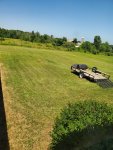Without loader, and without filled tires, I'd guess the front given engine weight. My old BX got light in the rear very quickly without a rear implement. But it's probably not just which end is heavier, but also which end you can get closer to the front of the trailer / put your Gator closest to. And I guess you should also wonder whether the Gator or the Kubota goes on first - I'd guess the Gator to be lighter perhaps, specially if you load it backwards.
Neil from Messicks did some videos where he was checking the weights on the individual wheels on a Kubota (I think a B, but maybe a BX). He was aiming to prove that ballasting the rear reduces load on the front axle I think from memory, but he did give weights by corner. But I think that was with loader on - IIRC the front axle had more weight than the rear. I'll see if I can find that.
Here's a link to a test he did on a New Holland in a similar size class - 60% of weight on the front, but with loader on:
. I'd guess with loader off it'd be more like 60% to the back - the loader weights a good couple hundred kg. Let's make up maths:
- tractor about 650kg (
https://www.orangetractortalks.com/forums/threads/bx-vs-b01-vs-b50.36719/)
- loader about 200kg (made up, but I know the bucket is about 60kg, so loader arms and cylinders must be a bit)
- So 850kg in total, 60% front with loader on = 510kg on the front, 340kg rear
- Take the loader off, that means 510-200=310kg front, 340kg rear
- So actually about 50/50, on that maths
There's another video with a BX, which gives actual weights:
That says 1300lbs on front axle with loader on. Which is 1300/2.2 = 590kg. He's got a rear ballast box on, so rear weight won't be accurate for our purposes.
But overall, I'd guess there's not much in it, and which end you can load closer to where you want is probably more important than which end is heavier.


